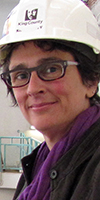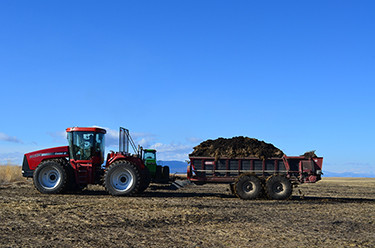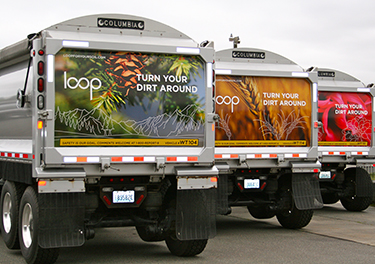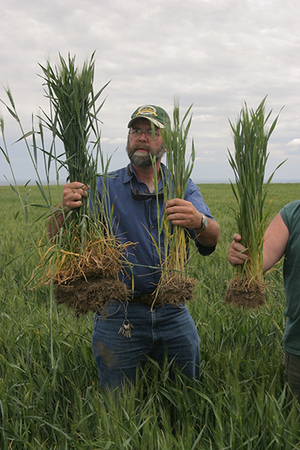|
Subscribe / Renew |
|
|
Contact Us |
|
| ► Subscribe to our Free Weekly Newsletter | |
| home | Welcome, sign in or click here to subscribe. | login |
Environment
| |
 |
September 25, 2014
How biosolids can curb greenhouse gases
King County Wastewater Treatment Division

Elardo
|
Each day more than 1.5 million people in the Puget Sound region unwittingly support King County’s effort to fight climate change — just by flushing a toilet.
For decades, King County’s Wastewater Treatment Division has created resources from sewage such as biosolids, a nutrient-rich substitute for fertilizer sold under the brand name Loop.
Biosolids are well known for improving plant and soil health. Now they are emerging as a potentially valuable tool in curbing greenhouse gas emissions.
How it works
Biosolids are produced through an advanced wastewater treatment process. Solids are separated and placed in a heated, oxygen-free environment for a month, which kills pathogens and breaks down harmful pollutants.
What remains is a rich, dark, earthy matter loaded with carbon and nutrients.
When biosolids are applied to land, some of the carbon remains in the soil, which keeps it out of the atmosphere. This process is called carbon sequestration, and it’s one way to mitigate some of the problems associated with climate change.
Biosolids also improve soil health and reduce erosion, which means plants grow larger and can take more carbon out of the atmosphere via photosynthesis. These plants not only store carbon in their tissues but eventually they’ll drop leaves and branches on the soil surface, helping to return even more carbon in the soil.
Finally, biosolids can reduce demand for synthetic fertilizer, which takes a tremendous amount of fossil fuel to manufacture.
By contrast, the production of biosolids actually creates energy because the beneficial bacteria generate methane during the treatment process. Some of this gas is used for heat and power at the treatment plants while the rest of it is sold to local utilities for distribution to their customers.
Smaller carbon footprint
Confronting climate change is a top priority for King County Executive Dow Constantine, who called for ambitious energy efficiency targets and investments in 2010 that are now realizing $2.6 million in annual savings for King County government operations.
The challenge is that wastewater treatment, though crucial for protecting regional water quality, is an energy-intensive process. Treatment facilities operate around the clock. The advanced levels of treatment and odor control favored by communities demand still more energy.
Through a combination of conservation, investment in energy-efficient equipment and making the best use of renewable resources, the Wastewater Treatment Division is doing its part to reduce its carbon footprint.
King County’s wastewater utility recycles 100 percent of the 120,000 tons of biosolids it produces each year. Between biosolids recycling and the production of renewable energy, the utility estimates its carbon offset is equivalent to 42,000 tons of CO2, which is like taking 8,000 cars off the road each year.
| Get in the Loop |
|
Information on King County’s Loop biosolids can be found at www.loopforyoursoil.com.
|
Capturing waste energy from its treatment plants has also helped King County surpass its goal of meeting the equivalent of half of the county’s energy needs through renewable energy in 2013.
The Wastewater Treatment Division’s resource recovery efforts are just some of the steps King County is taking to make communities, the economy and environment more resilient to climate change impacts.
The county is also working with the broader community to reduce county-wide emissions by 80 percent by 2050.
A proven, beneficial practice
Though the safety and benefits of biosolids recycling and use are well-documented and grounded in rigorous science, opposition to the practice exists.
In reality, King County’s Loop biosolids is far more heavily regulated than manures, yard waste composts and synthetic fertilizers.
Decades of research from universities, the EPA and the National Academy of Sciences shows that biosolids are safe for people and the environment when used according to regulations and best management practices.
With an emphasis on creating resources from wastewater, King County is working hard to become one of the nation’s first carbon-neutral wastewater utilities.
Recycling biosolids will play a critical role in making that vision a reality.
Pam Elardo is the director of King County’s Wastewater Treatment Division. Elardo has a master’s degree in environmental engineering from the University of Washington and a bachelor’s degree in chemical engineering from Northwestern University. She is also a licensed Professional Engineer and certified Group IV Wastewater Treatment Plant Operator.
Other Stories:
- Passive House finds a permanent home in the Northwest
- Survey: Landau Associates
- Survey: HWA GeoSciences
- Survey: Eco Chemical
- Survey: Environmental Resources Management
- Survey: WISErg Corp.
- Survey: Environmental Sciences Associates
- Survey: Farallon Consulting
- These modular classrooms are not old school
- Local firms invent modules to protect Louisiana coast
- Old mining pond becomes new salmon habitat
- Time to jump on contaminated urban properties?
- Tackling toxics with green chemistry
- Lower Duwamish: watershed management poster child?
- Is hard water drowning Eastern Washington’s economy?
- Preserving Seattle’s largest forest takes a group effort
- Being green is not just about checking boxes
- Carbon-rich tidal wetlands down, but not out
- Survey: Herrera Environmental Consultants





